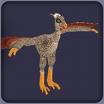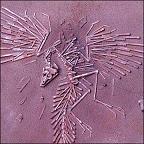-3-
Preferred fight or flight response indicates a difference in personaliy 

There are two recurring patterns to respond to dangers or threats seen in nature: to fight or to flee. Although both options will be present, a first preference seems to be genetically determined. It would makes sense. In nature, whether or not to be able to respond quickly to a threat is often a matter of life or death. Then you do not need to think twice on the reaction. This preference leads to profound differences in muscular, cognitive and behavioral development. You can speak of a difference of character. In-group-living animals sometimes within the same species have sometimes these differences in character development, a functional specialization for the group survival. The 'fighter' is the one who is looking for new ways to get food, takes risks. An example that the 'fittest' does not always have to be the best survivor, he is geared up for the survival of the group as a whole to take risks.
The two character types have been studied in rats-in-groups. When rats are fighting, they do that with the mouth. One type, the "risk taker", rankles much permanently and the other not much. This shows how far-reaching these differences are. In humans, the difference in tendency to fight or to flee are to be found in the archetypes of the extraverted towards the introverted character, the one type reacts in "danger" (as the stress hormones adrenaline and cortisone are activated) initially with anger (the fighter type) and the other type with a primary reaction of scareness (the fleeing type). These basic characteristics also influence the development of the interest of a person. The introverted type will more likely focus on music, rather than on fighting.
Moreover, women generally have a very different response to 'danger' than men have (even if they have similar genes). When they have stress they will look for social contacts even more often than they tend to do as usual.
Three character components 

 In animals within the two character types fight or flee one can observe gradual genetic-determined differences in the degree of fight and flight. In humans also are both behavioral responses to varying degrees present. A third component in the character is the (degree of) activation of the opioid (love-) areas in the brain. Based on combinations of these three components and their differences of degree, the psychologist Cloninger identified 24 personality types. As fight and flight in humans are associated with strong emotions like anger, fear, triumph and pride, the opioid areas are associated with strong emotions from joy and sorrow. The character is so connected with the most emotional. Emotions tend to occur in relation to other people.
In animals within the two character types fight or flee one can observe gradual genetic-determined differences in the degree of fight and flight. In humans also are both behavioral responses to varying degrees present. A third component in the character is the (degree of) activation of the opioid (love-) areas in the brain. Based on combinations of these three components and their differences of degree, the psychologist Cloninger identified 24 personality types. As fight and flight in humans are associated with strong emotions like anger, fear, triumph and pride, the opioid areas are associated with strong emotions from joy and sorrow. The character is so connected with the most emotional. Emotions tend to occur in relation to other people.
Character development
The conclusion is that there are many different characters connected to different 'institutions' of those 3 basic systems (Spinoza suggests that there is another system, a system which connects with other people. This system is to Spinoza 'the highest good', which gives a durable good feeling, a 'reward' of internal 'Peace'). Most probably distribution in characters is a good survival strategy for humans. It provides flexibility in adapting to the environment. Extra flexibility is that some genes may change even during development, because these genes can be influenced by the environment. This is called epigenesis. Epigenesis is most clearly demonstrated in the influence of hunger, it seems (to me) likely that other hormones too are associated with epigenetically functioning systems.
Genes, epigenesis, age, diseases A genome has many genes. Many features, such as dark or blue eyes are genetically determined and are fixed throughout life. In the course of evolution one sees wonderful adaptations to extreme conditions with impressive results. The gene selection changed under environmental influence. The pictures show examples of transitional forms of amphibians to birds. Because the 'institutions' for reactions in humans can change, the behavior does change during the life within genetically-specified margins. Humans are more flexible during their own lifetime than most animals are. The experience of violence can change people, much meditation, hunger or overeating too. Many changes are independent of conscious will. They occur because the brain itself tries to adapt to changing circumstances.
A genome has many genes. Many features, such as dark or blue eyes are genetically determined and are fixed throughout life. In the course of evolution one sees wonderful adaptations to extreme conditions with impressive results. The gene selection changed under environmental influence. The pictures show examples of transitional forms of amphibians to birds. Because the 'institutions' for reactions in humans can change, the behavior does change during the life within genetically-specified margins. Humans are more flexible during their own lifetime than most animals are. The experience of violence can change people, much meditation, hunger or overeating too. Many changes are independent of conscious will. They occur because the brain itself tries to adapt to changing circumstances. 
Deviant behavior patterns show what may occur in all people. Extreme conditions can lead to extreme changes in the brain and to behavioral impulses, that in the circumstances of later life do not come in handy. The younger these extreme conditions, the more defining they are for later life. Probably they can be stored in the genes (by soms kind of epigenetic proces). Psychiatric disorders and strongly from the average deviant behavior patterns, which are known to have their origin very early in life or are congenital, are likely to be reduced to extreme settings of the circuits, possibly in the inter-relationship of these circuits. The experience of extreme aggression in early childhood, neglect, have demonstrable effects on later behavior. Moreover these experiences tackle not necessarily bad, sometimes forcing to changes in the brains subsequently be viewed favorably. The past century has been much influenced by Freud, including much attention for what may happen in early childhood. The influence of conditions of the mother during pregnancy and the genetic predisposition, has been uderestimated in comparison with the attention to childhood (D. Swaab: Wij zijn ons brein).
Self influencing the brain temporarily or for a long term
That the same substance, eg cocaine, is calming for an extremely busy person and gives unrest to a quiet person, can be explained by a difference in 'institutions' of the hormone systems. Receptors want to be filled with behaviors evoked by substances. Therefore psychoactive substances can replace addictive behavior which is normally turned on from the inside. This explains why sometimes opiates are used by persons with a tendency for psychosis as a kind self-medication. And why they are processed into medical drugs. New receptors can be formated by behavior and by signaling molecules for that behavior. In the sameway receptors can disappear. Sometimes one finds this desirable. Because a good dosage is desirable, it is right to consult a doctor, for it to be a genuine medicine.
The BBC documentary 'Living with ADHD shows two mothers with a busy ADHD-child. One of the mothers (in the picture with her two children) is also herself as busy as her child. She understands better than the other parent (without ADHD herself) that the child's behavior can not change and she therefore can more easily cope with the situation. The documentary says that she uses cocaine te get more quiet. She found out that psychoactive substances can help her.
People influence their own brain by multiple ways for example medications, therapies, education, yoga, etc.. Another example is an person who after a long flight resets his internal clock by not eating for a longer time than ususal.

